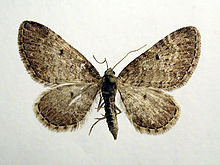Satyr pug
| Eupithecia satyrata | |
|---|---|
 |
|
 |
|
| Scientific classification | |
| Kingdom: | Animalia |
| Clade: | Euarthropoda |
| Class: | Insecta |
| Order: | Lepidoptera |
| Family: | Geometridae |
| Genus: | Eupithecia |
| Species: | E. satyrata |
| Binomial name | |
|
Eupithecia satyrata (Hübner, 1813) |
|
| Synonyms | |
|
|
Eupithecia satyrata (satyr pug) is a species of moth of the Geometridae family. It was described by Hübner in 1813. It is found from Ireland, through northern and central Europe (from Scandinavia to the Northern Mediterranean) East to all of Russia and Central Asia and West Siberia to Tibet. It is also present in North Africa and North America.
The wingspan is 18–24 millimetres (0.71–0.94 in). Eupithecia satyrata is variable in pattern. The ground colour of the wings is ash grey or brownish. The veins often have a black with white dusting.There are paler crosslines.On the forewings a very indistinct terminal fascia ends in a tiny tornal spot. There is fine discal spot on the forewing. This is absent on the hindwing.
Adults are on wing from March to September. There is one generation per year.
The larvae feed on the flowers of a wide range of plants, including Achillea, Scabiosa, Solidago, Senecio and Erica tetralix.
...
Wikipedia
